28 December 2019
Originally published
29 March 2019
Homeless people often die alone. Europe’s first hospice for the homeless was set up to accompany them on their last journey. Rather than leaving them to die anonymously on the streets or in emergency shelters, the hospice offers them care and comfort during their final hours.
They had an appointment. But Hans Mitterbacher failed to keep it. For more than an hour, three women have been waiting in the small office of the hospice. He knows he was supposed to see them for a check-up. But instead of returning right after his radiation therapy at the hospital, he has gone for a walk. Taking a walk means that sooner or later he will end up at the local pub, just a few hundred metres from the hospice, drinking beer and smoking. Doctor and nurses are left waiting, while he does the things that are partly to blame for his health issues.
“It happens,” says Désirée Amschl-Strablegg. The 45-year-old heads the palliative care team at the VinziDorf hospice, Europe’s first, and so far only, hospice care facility for the homeless. Opened in April 2017 in the grounds of the St. Leonhard municipality cemetery in the east of Graz, it provides a home to people without a permanent residence, health insurance or money: people with moving life stories, suffering from serious illnesses. Sometimes it’s their first home, almost always their last.
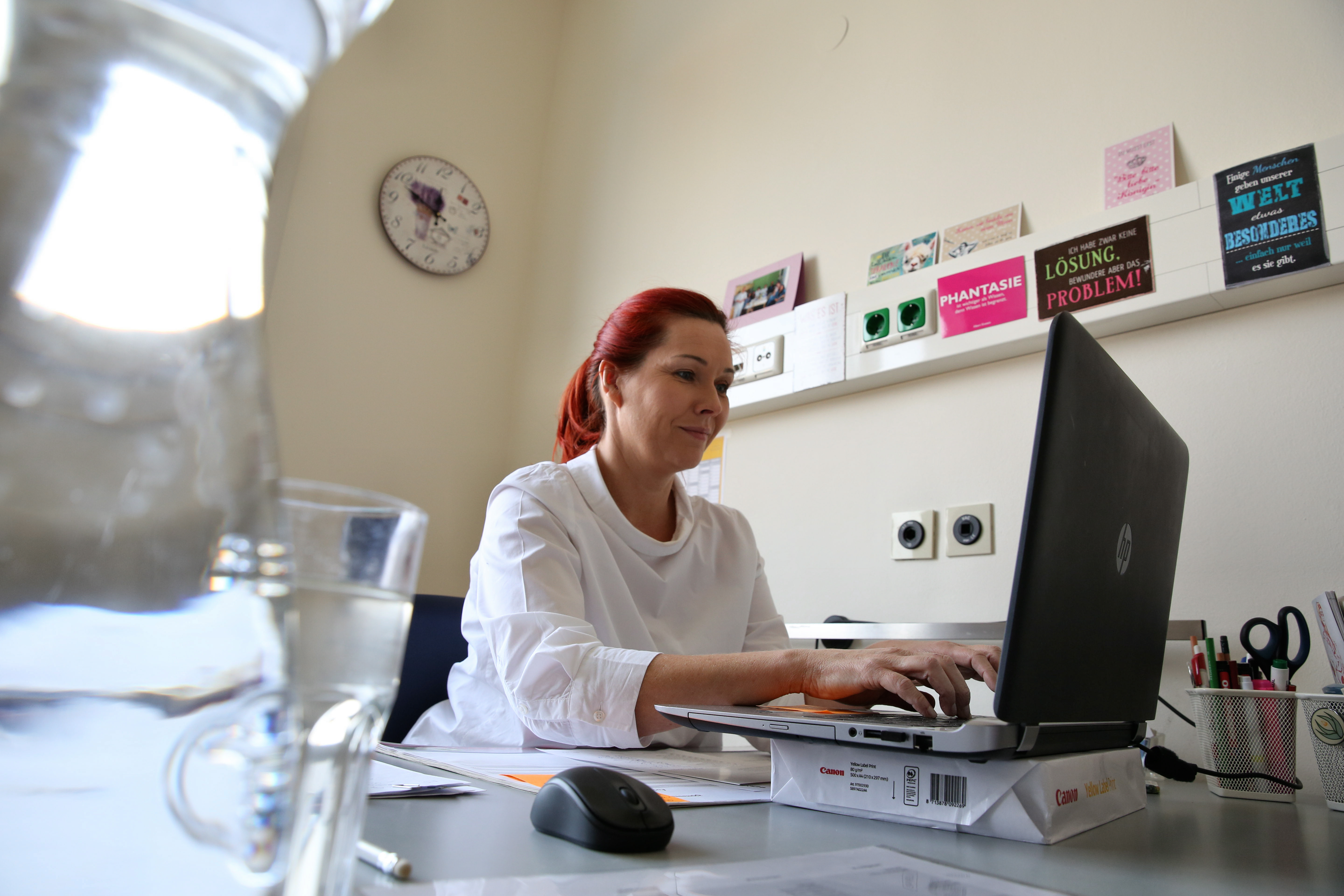
Désirée Amschl-Strablegg is heading the palliative care unit at the Order of Saint Elisabeth Hospital in Graz and at the VinziDorf hospice. Photo: © Sascha Montag / Zeitenspiegel
Those who have fallen through all the safety nets that society provides, who can no longer gain a foothold in it, often die alone, on park benches or in emergency shelters. Many of them eschew hospitals, palliative care units and hospices. “Their unorthodox way of living makes it difficult for them to cope with the structures of conventional facilities,” explains Amschl-Strablegg. Those suffering from terminal illnesses feel misunderstood and deprived of their freedom by the requirement to abstain from alcohol.
“We try to accommodate their unconventional lifestyles,” says Amschl-Strablegg. But the homeless hospice also has rules. Residents are required to keep noise down to a minimum at night, for their own protection. They are, however, permitted to drink beer and wine, smoke cigarettes, and receive visits from friends from the streets. The hospice, which is funded by donations, has room for two guests, as the residents are called. A caregiver is available 24 hours a day; a group of nurses and healthcare professionals is involved, plus volunteers.
Living and dying in close community
Inside, the hospice does not have the feel of a place of death. In the eat-in kitchen, music videos flicker across the TV screen and the smell of roast chicken that was served for lunch still lingers in the air. Sara, a former resident’s cat, has curled up in one of the laundry baskets in the hallway, purring. You have to look closely to find any evidence that people spend their last moments here: like a vase filled with little stones in the kitchen. A helper has written the names of the deceased on the stones: Michael, Ondre, Mr Ludwig.
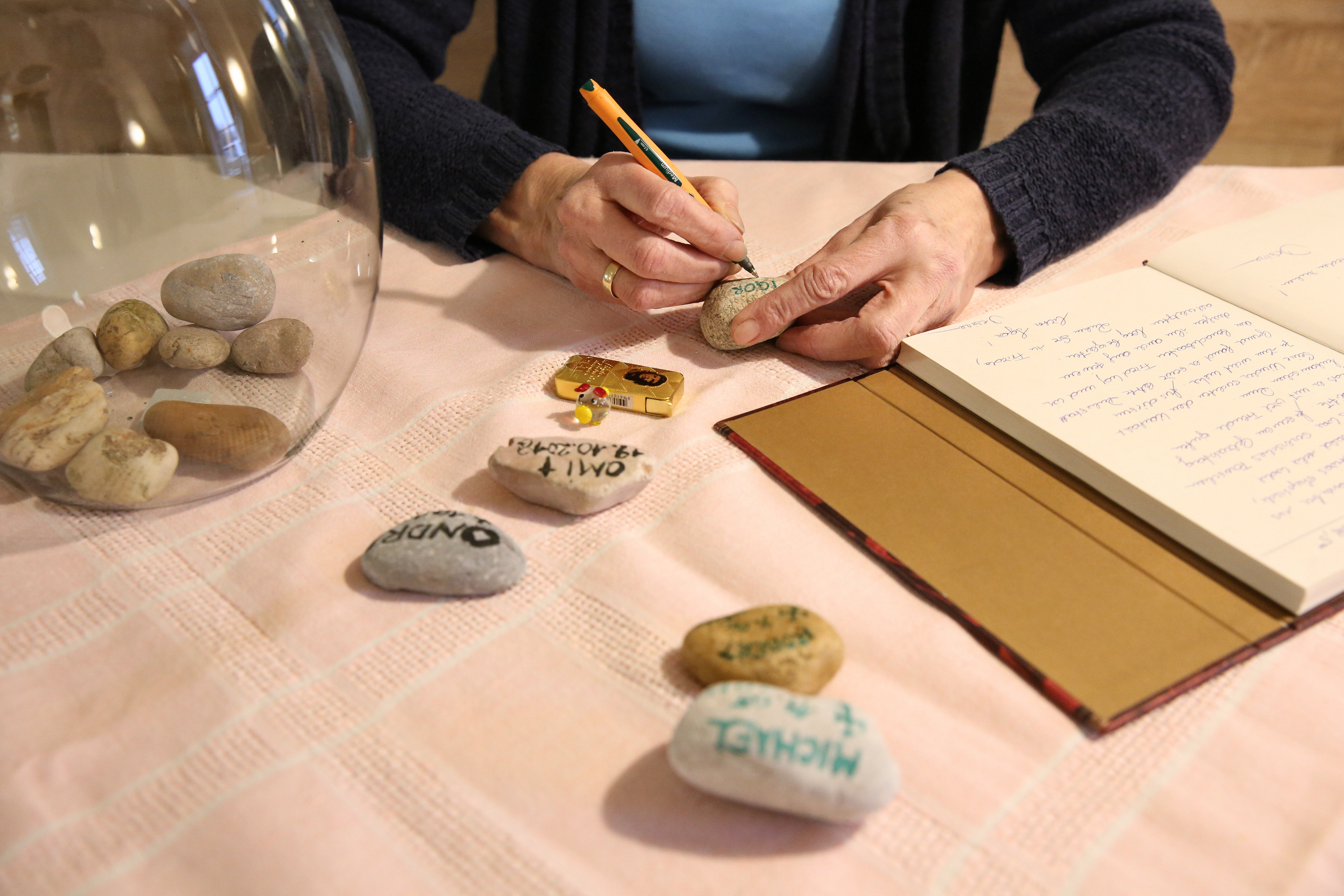
In the kitchen is a vase filled with little stones. The names of the deceased are written on them. Photo: © Sascha Montag / Zeitenspiegel
To die, many of the guests only had to walk across a narrow path. They came from VinziDorf, a container settlement located directly opposite the hospice. It was founded over 25 years ago by Wolfgang Pucher. Known in Graz as the “priest of the poor”, Pucher wanted to give a home to homeless and chronically alcoholic men, a place they couldn’t find anywhere else in the city. Unlike emergency night shelters and other homeless facilities, this settlement offers a seven-square-metre container to anyone who comes here, for as long as they want.
“When we thought about where in Graz to open the hospice, it quickly became clear that this is the right place,” says Amschl-Strablegg, who has been heading the palliative care unit at the Order of Saint Elisabeth Hospital in Graz for seven years. Nuns of the order came up with the idea for the hospice.
A free hospice bed
Hans Mitterbacher also moved to the hospice from VinziDorf, where container No. 2a still belongs to him. There’s a guitar on his bed and postcards and pictures of idyllic mountain landscapes cut out of magazines on the wall. The settlement manager, Sabine Steinacher, had to promise him that she would leave everything in his container as it was – until he returns or until he dies.
Mitterbacher first came to VinziDorf four years ago. He was already an alcoholic back then, had suffered several strokes, had severe liver damage and was incontinent. It quickly became clear that they could not look after him in the state he was in. He was admitted to a nursing home, where he tended the rabbits, goats and cats. It did him good. Soon, he was also recovering physically. But when he could no longer stand the home’s strict rules, in particular the alcohol ban, Mitterbacher moved out, wandering around, sleeping rough or in shelters. In April 2018 he returned to VinziDorf. Before long, his condition worsened again. He lost a lot of weight and was always hoarse. Last autumn, he was diagnosed with laryngeal cancer. The tumour is irradiated several times a week. To make it easier for him to breathe, he has been fitted with a cannula and a gastric tube for feeding. Sabine Steinacher didn’t have the heart to send him back to another nursing home. “We would have torn him away from the environment he’s familiar with once again.”
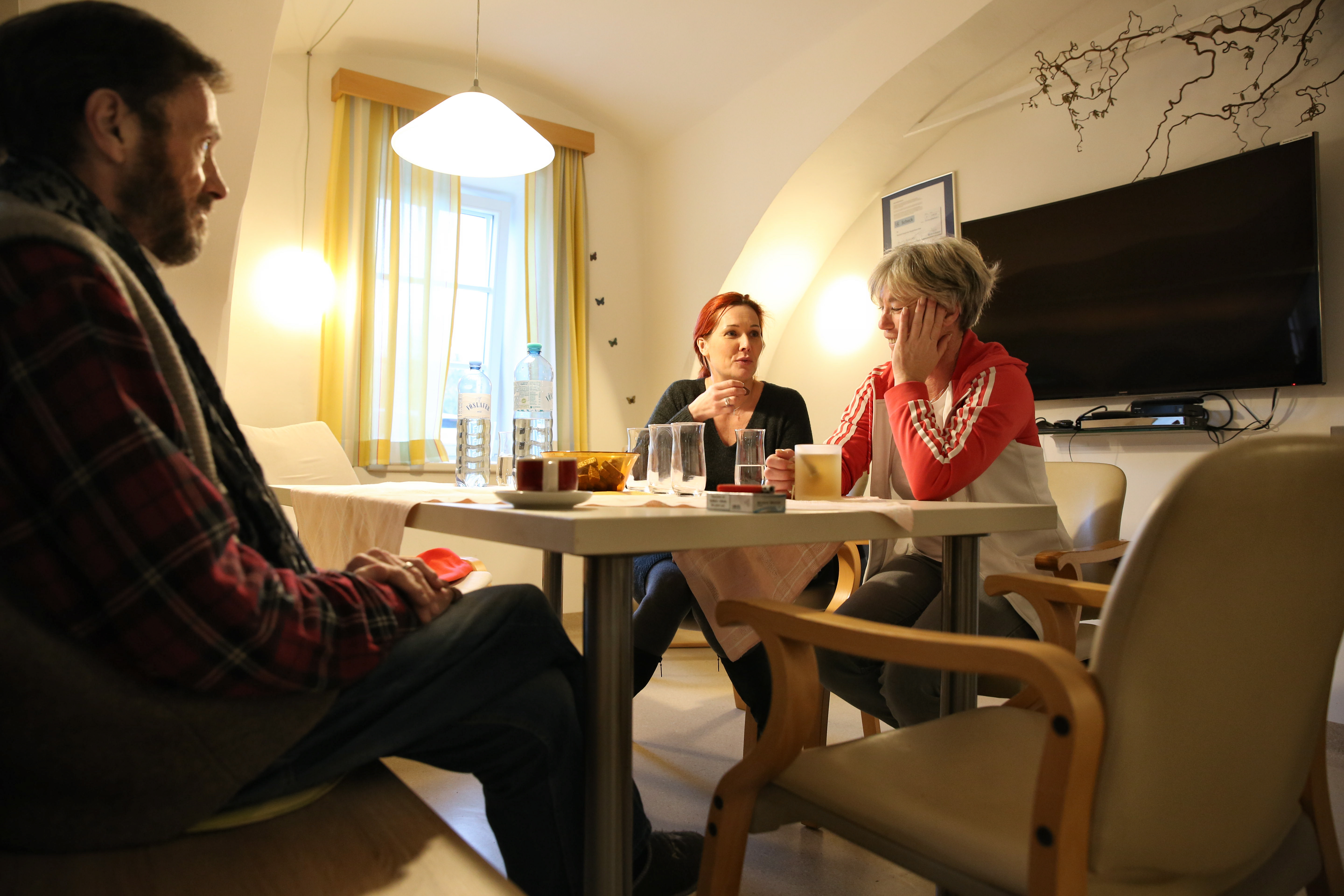
Désirée Amschl-Strablegg and Anette Erdeli, who is a nurse at the VinziDorf hospice, are having a coffee with the resident Hans Friedrich Mitterbacher. Photo: © Sascha Montag / Zeitenspiegel
Hans Mitterbacher was lucky. A bed at the hospice was available only a few steps from his container. Anette Erdelji cares for him day and night: she prepares banana milk puree when the pain makes it difficult for him to swallow, selects shirts, sweaters and jackets from a stash of donated clothes, or just listens to him.
No contact with his family
“There is nothing left of me,” says Hans Mitterbacher, his voice rattling. He has difficulty speaking for long periods of time. He looks down at himself, raises his thin arm. “I can tell that I have lost twenty kilos.” “Of course you can,” replies Anette Erdelji, who sits facing him. Mitterbacher, his cheeks sunken, has lifted up his T-shirt to expose the end of the gastric tube. The caregiver uses a syringe to pour a light mash into the feeding tube. “Are you nervous?” the 47-year-old asks, in her Croatian accent, rolling her Rs. She takes his right hand, squeezes it gently. She smiles. “The two of us, we can do it.”
Born 64 years ago in Carinthia, Mitterbacher grew up with four siblings in eastern Styria and trained as a car mechanic and electrician. Later he enlisted in the Austrian army, serving in Cyprus. He married and had a daughter. No one visits him at the hospice. He has no contact with his family or his daughter.
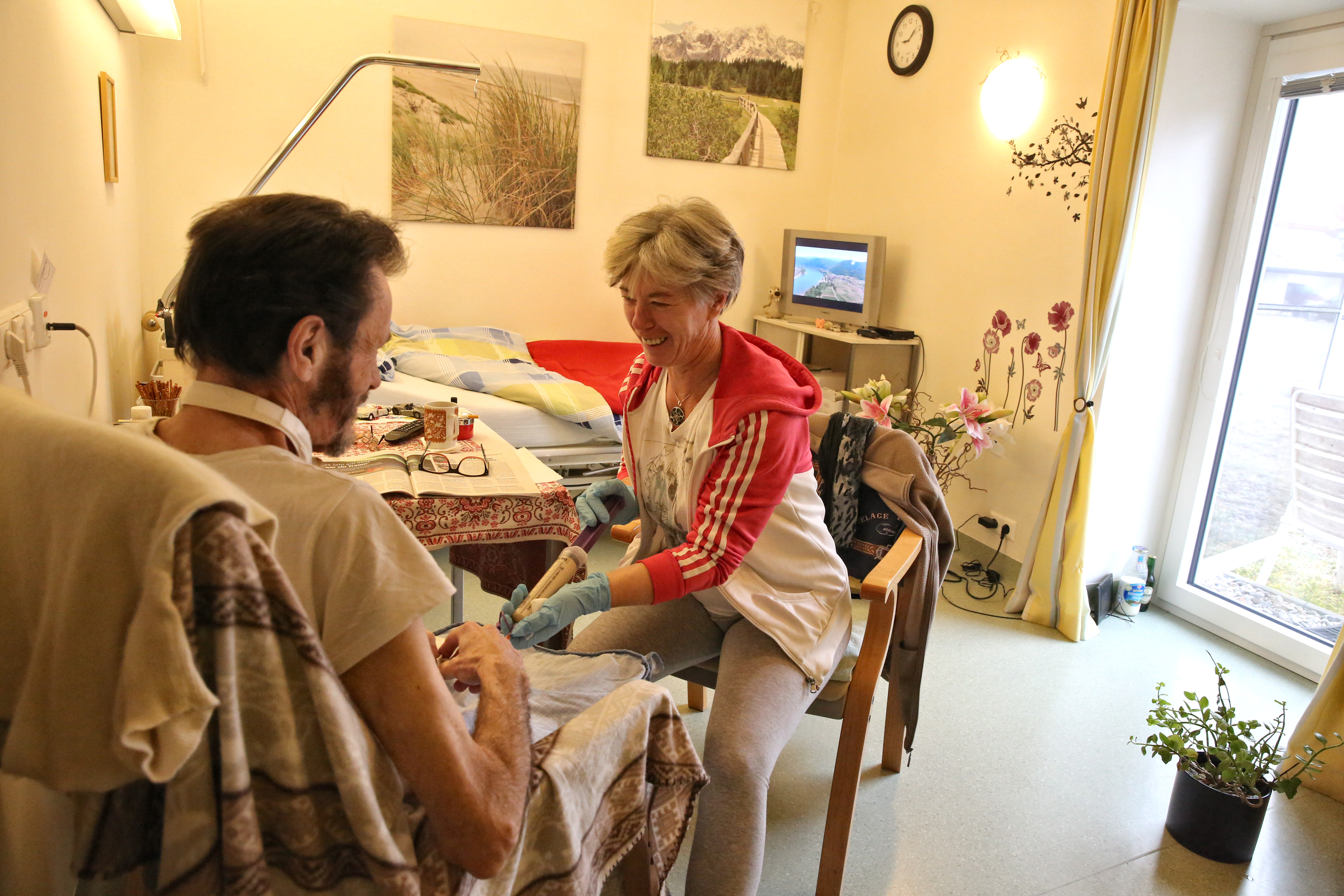
Anette Erdeli takes care of Hans Friedrich Mitterbacher day and night. She prepares banana milk puree when the pain makes it difficult for him to swallow, selects shirts, sweaters and jackets from a stash of donated clothes, or just listens to him. Photo: © Sascha Montag / Zeitenspiegel
It takes him a long time to trust people, to accept help. But Anette Erdelji won’t give up on him. Since he moved to the hospice, he has gained two kilos and 200 grams. When she talks about this small success, you can sense her hope for a brief moment. If he regularly attended radiotherapy, would his condition perhaps stabilise? Would they then be able to remove the cannula and the gastric tube? Would he then perhaps be able to move back in his VinziDorf container? Mitterbacher wouldn’t be the first guest of the homeless hospice to be nursed back to health by doctors and caregivers.
Perhaps the last goodbye
A total of 17 people has been accommodated at the hospice since its inception. The longest stay lasted nine months. Josef, on the other hand, only spent a weekend there. While Hans Mitterbacher and Anette Erdelji are smoking a cigarette just outside the hospice, a candle flickers next to them. It is lit whenever one of the guests dies. Josef is already the second roommate that Mitterbacher has lost within three weeks. “It’s very difficult for the other resident when someone dies,” says Anette Erdelji. “Hans has told me he will be next.”
She is sitting in a rocking chair in a corner of the living room and holding a notebook on her lap with memories of the deceased: a few lines of text, some pictures. Erdelji turns the pages. She smiles. “People say it gets easier every time but that’s not true. You never get used to seeing people die,” she says. “This is a nice place, we have a lot of fun, but accompanying people during their last moments of life, witnessing their suffering, is very hard.”
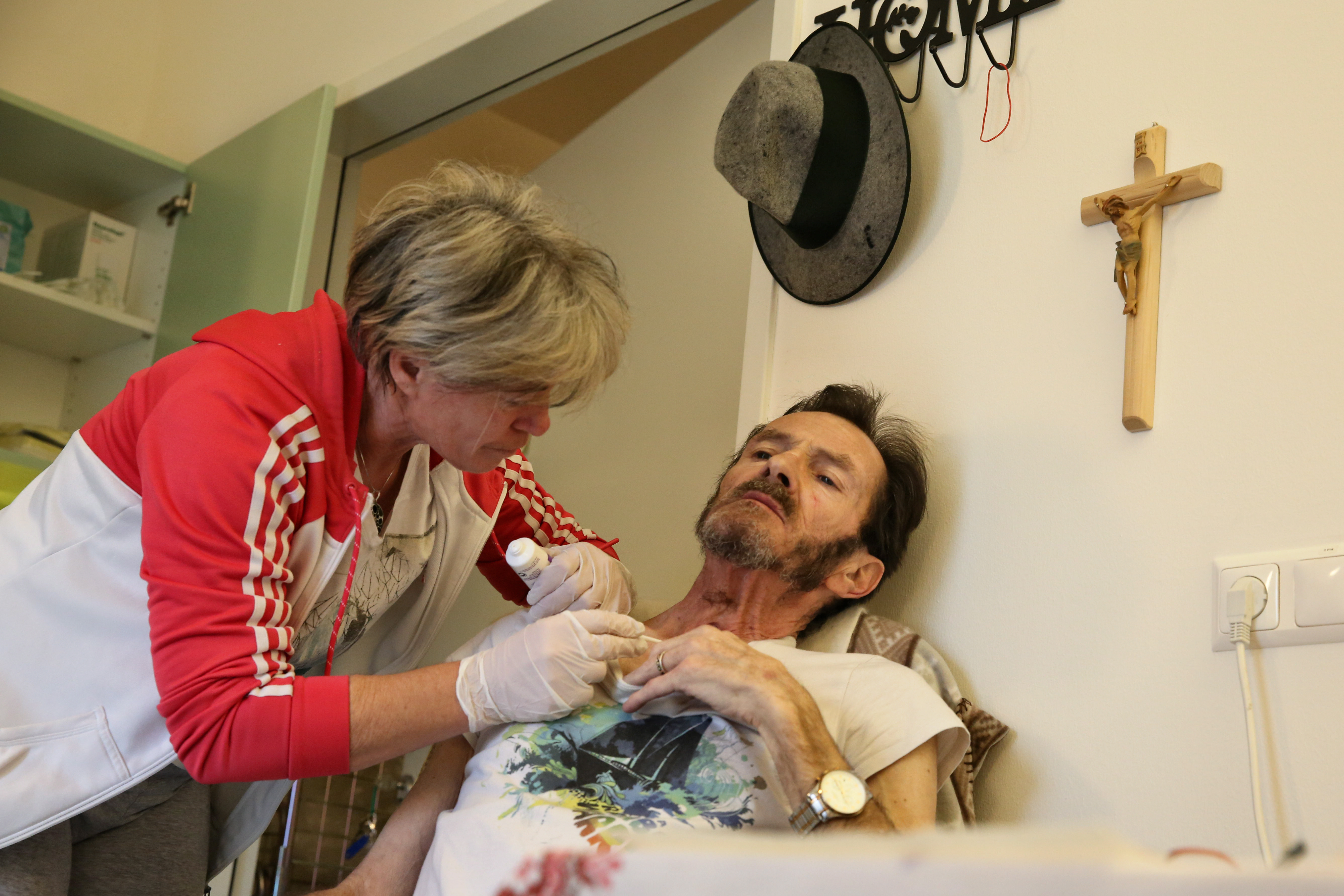
“There is nothing left of me,” says Hans Mitterbacher, his voice rattling. He has difficulty speaking for long periods of time. Photo: © Sascha Montag / Zeitenspiegel
The following morning, Anette Erdelji and Hans Mitterbacher have to say goodbye. He’s about to go for a walk, has put on his coat and hat. Having spent three weeks in Graz, for Erdelji it is time to return to Croatia to be with her husband and her two children. Another nurse will take over Mitterbacher’s care during the next weeks. He hugs her and strokes the back of her head, running his fingers through her short hair. “Always eat up, won’t you,” she says. “Yes, Ma’am,” he replies, tips his hat, pushes it up a bit and disappears into the cold air.
Even though Anette Erdelji is wearing a colourful blouse and has put on some make-up for her journey home, she looks more tired and sadder than usual. Will the people with whom she shares her everyday life still be alive when she returns? She doesn’t know: each farewell can be the last.
Two months after this research, Hans Mitterbacher died at the VinziDorf hospice. He had stopped attending radiotherapy, flouting all the advice. “He taught us a wonderful lesson with that,” writes Désirée Amschl-Strablegg in a message informing reporters about his death. “That’s exactly how he was able to do what he wanted until his last day… live!”
Original in German. An amended version of this story was published on in the digital edition of Der Spiegel 14/2019 and on 29 March 2019 at spiegel.de.
Translation into English by Barbara Maya.
This text is protected by copyright: © Rike Uhlencamp / Zeitenspiegel. If you are interested in republication, please contact the editorial team.
Copyright information on pictures, graphics and videos are noted directly at the illustrations. Cover picture: Cat Anna in the VinziDorf hospice. Photo: © Sascha Montag / Zeitenspiegel